The Vittala Temple, also known as the Vijaya Vittala Temple, situated in the historic site of Hampi, is a remarkable testament to the architectural brilliance of the Vijayanagara Empire. Hampi, a UNESCO World Heritage Site located in the southern state of Karnataka, India, was once the majestic capital of this empire. The Vittala Temple, dedicated to Vittala, an incarnation of Vishnu as Krishna, this 15th-century masterpiece is a dazzling testament to the artistry and engineering prowess of the bygone era. It’s considered the most prominent temple and monument in Hampi.
The Vijay Vittala temple is located in the northeastern part of Hampi, near the bank of Tungabhadra River. To get to this temple, you can follow the path from Hampi Bazaar towards the northeast. It’s approximately a 30-minute walk from the bazaar area, which is 2 kilometers away. Alternatively, you can hire a local auto-rickshaw or bicycle to reach there conveniently, via Kamalapura town. However, this distance is 9 kilometers from Hampi bus stand.
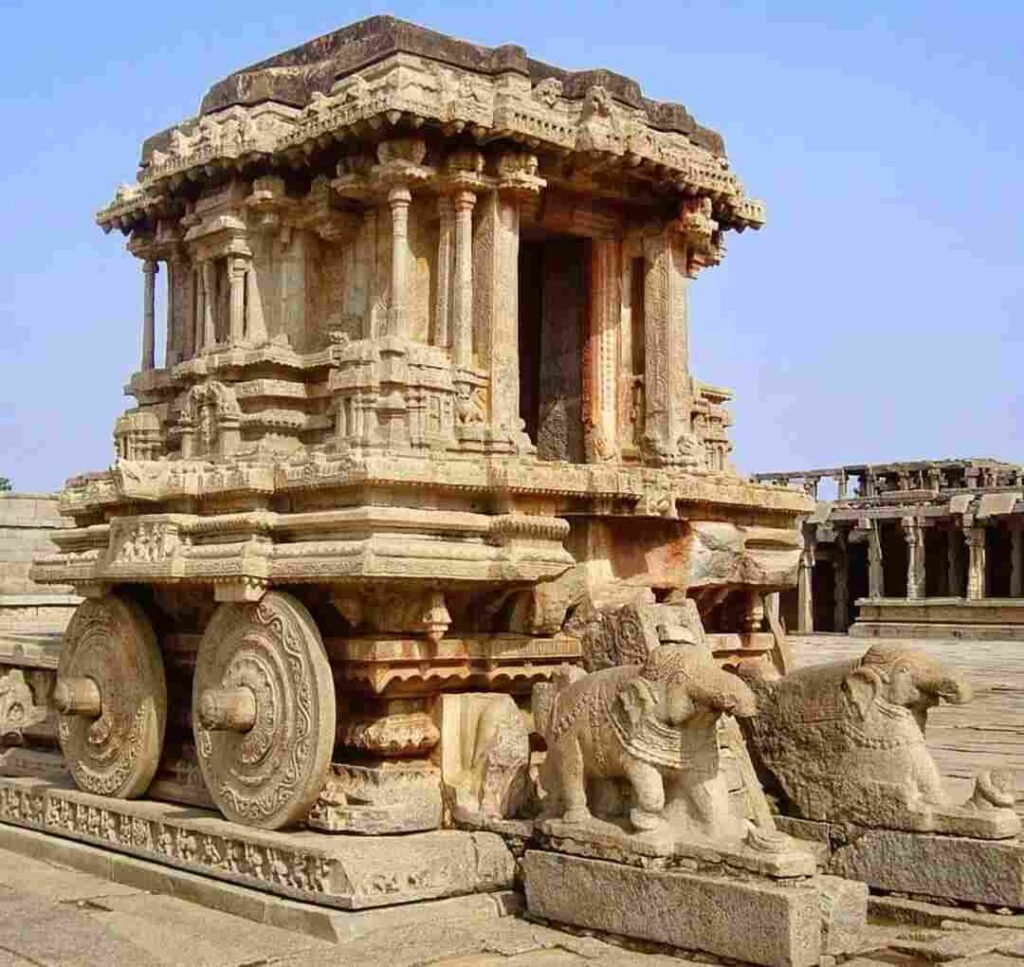
Table of Contents:-
This temple as a living testament to the artistic brilliance and cultural heritage of the Vijayanagara Empire. Its awe-inspiring architecture, musical pillars, and the iconic Stone Chariot make it a must-visit destination for history enthusiasts, architecture lovers, and spiritual seekers alike. Exploring the Vittala Temple and its surroundings is a journey back in time, offering a glimpse into the rich cultural tapestry of ancient India.

credits: @meinbhiphotographer
Quick Facts
- Timing: 08:30 AM to 06:00 PM
- Entry Fee: Entry fee required
- Photography: Allowed
- Location: Google Maps
- Must-See Attractions
History of Vittala Temple
The Vittala Temple is revered as the ultimate example of Vijayanagara art and architecture, showcasing the opulence and advanced craftsmanship of its time. Believed to have been commissioned by Devaraya II (1422 – 46 CE), its origins are rooted in the Uttara Narasimha Purana, which mentions Proluganti Tippa, a trusted general of Devaraya II, constructing a bhogamandapa (food preparation pavilion) for the deity Vittalapathi.[1]
The exact date when the Vittala Temple was built is still uncertain because there isn’t much evidence available. The 100-columned hall, which extends to the enclosure wall, features a trilingual inscription in Kannada, Telugu, and Tamil dating back to 1516. It records that the temple was built by Krishnadevaraya (1509 to 1529 CE).[2]

Architecture of Vittala Temple
The temple is dedicated to Vittala, an incarnation of Vishnu as Krishna. With a courtyard measuring 500 by 300 feet and an average height of 25 feet, the Vijay Vittala temple is built in the Dravidian style of architecture. The temple faces east and consists of a garbhagriha (sanctum), antarala (antechamber), pradakshinapatha (circumambulatory passage) around garbhagriha and antarala, rangamandapa (pillared hall) and maha rangamandapa (large pillared hall). The maha rangamandapa added in 1554 CE was identified as Uyyale (swing), mandapa and some of its pillars when tapped gently, produce musical notes.

An architectural marvel of the Vijayanagara empire, the vahana shrine for housing the image of Garuda is in the form of a stone chariot and resembles a processional wooden chariot. The temple complex also consists of hundred pillared mandapa constructed by Krishnadevaraya, two kalyana mandapas, Lakshminarayana shrine, Adinarayana shrine, another shrine on the southwest and shrine Alwars.
All these are enclosed a prakara wall with gopuras on the south, north and east. Those on the east and north were built in 1513 CE by the two queens of Krishnadevaraya. These entrances were like decorated towers, but sadly they are mostly broken now. Even though they are ruined, you can still see some parts of these old entrances. These leftovers remind us of how amazing the temple must have been a long time ago, and they show us the cool history of building at Hampi.
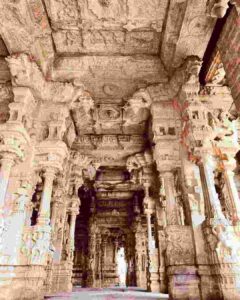
Musical Pillars of Vittala Temple
The Vittala Temple boasts a fascinating feature that draws visitors with its enchanting musical pillars. Let’s explore the magic of these pillars and learn more about their secrets.
Composition and Sounds:
The musical pillars in the temple are made of solid granite stone. When gently tapped, they produce a variety of musical sounds, delighting everyone who hears them. There are 56 musical pillars in the Ranga Mandapa, affectionately called SAREGAMA pillars because of the musical notes they create. Each major pillar is surrounded by seven minor pillars, each emitting different musical notes. These notes vary depending on the type of instrument represented, such as percussion, string, or wind instruments. Researchers have studied the pillars to understand their secrets. While they are not hollow, it’s believed that the presence of silica in the pillars contributes to their musical sounds.[3]
Design and Arrangement:
Inside the Mandapa, there are both large and small sets of pillars. The main pillars, designed to resemble musical instruments, support the ceiling of the Ranga Mandapa. To ensure the pillars’ sounds are not affected by the room’s acoustics, there are no side-wall enclosures. Some clusters have two or three pillars with the same frequency, creating a beautiful resonance when struck.
Unique Pillars and Sculptures:
Among the musical pillars, one has a damaged sculpture of a cymbal player, creating higher-pitched tones resembling cymbals or Nattuvangam. Another pillar features a sculpture of an Mridangam player, producing deeper pitches similar to an Mridangam drum. Additionally, a pillar with a classical dancer sculpture is thought to depict Chinnamma Devi, Krishnadevaraya’s queen and she was a well known supporter of the arts and a renowned classical dancer. Some say she was the inspiration for the magnificent Ranga Mandapa and Musical Pillars of Vittala Temple at Hampi.
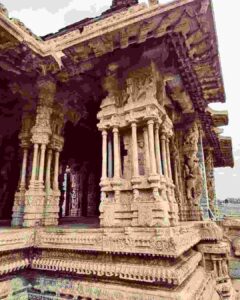
The Stone Chariot of Vittala Temple
The Stone Chariot is one of the most iconic attractions of the Vittala Temple complex in Hampi, captivating visitors with its majestic presence and intricate details. It was originally dedicated to Lord Garuda, the divine vehicle of Lord Vishnu.
Historical Context:
Built during the 16th century under the reign of King Krishnadevaraya, the Stone Chariot was inspired by the chariot of the Konark Sun Temple in Odisha. It stands as a testament to the artistic prowess of the Vijayanagara Empire and the Dravidian style of architecture.
Architecture and Design:
The Stone Chariot is not just a giant sculpture; it’s a marvel of design and engineering. While it appears to be a single, monolithic structure, it’s actually built from intricately carved granite slabs cleverly joined together. The skilled artisans ensured these connections are well hidden, creating the illusion of a solid block.

The Stone Chariot rests on a high rectangular platform adorned with intricate carvings depicting mythical war scenes. The design of the chariot draws inspiration from traditional raths, or temple chariots, reminiscent of traditional chariots used in temple ceremonies. The four massive wheels and the detailed carvings of gods and goddesses on the chariot’s pillars echo this rich tradition. This intricate detail work continues throughout the structure, showcasing the exceptional skills of the bygone era’s craftsmen and architects.
While two powerful elephants appear to be pulling the chariot today, this wasn’t always the case. Originally, the design featured two horses in harness. Look closely behind the elephant sculptures, and you can still see remnants of the horses’ tails and hind legs. The change from horses to elephants likely happened later. A broken stone ladder once gave access to the sanctum is kept between the elephants. You can still spot the marks on the floor and the doorsill where once the ladder stood.
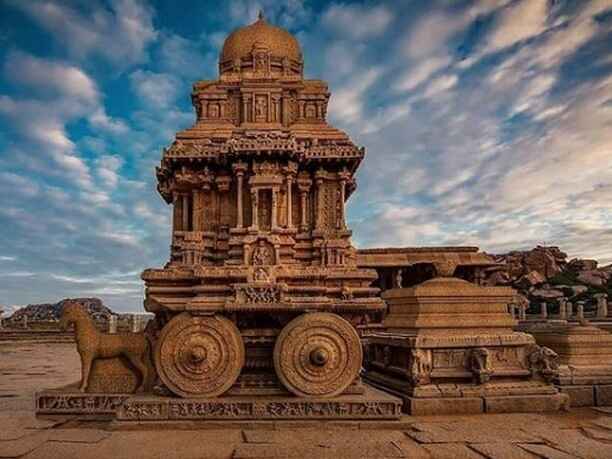
Back when the temple was at its best, the stone chariot would have been painted in vibrant colors using natural dyes. You can still see the remains of the painting on the carvings of the chariot. In the past, there used to be a small tower on top of the stone chariot. However, in the 1940s, the tower above the chariot was demolished.
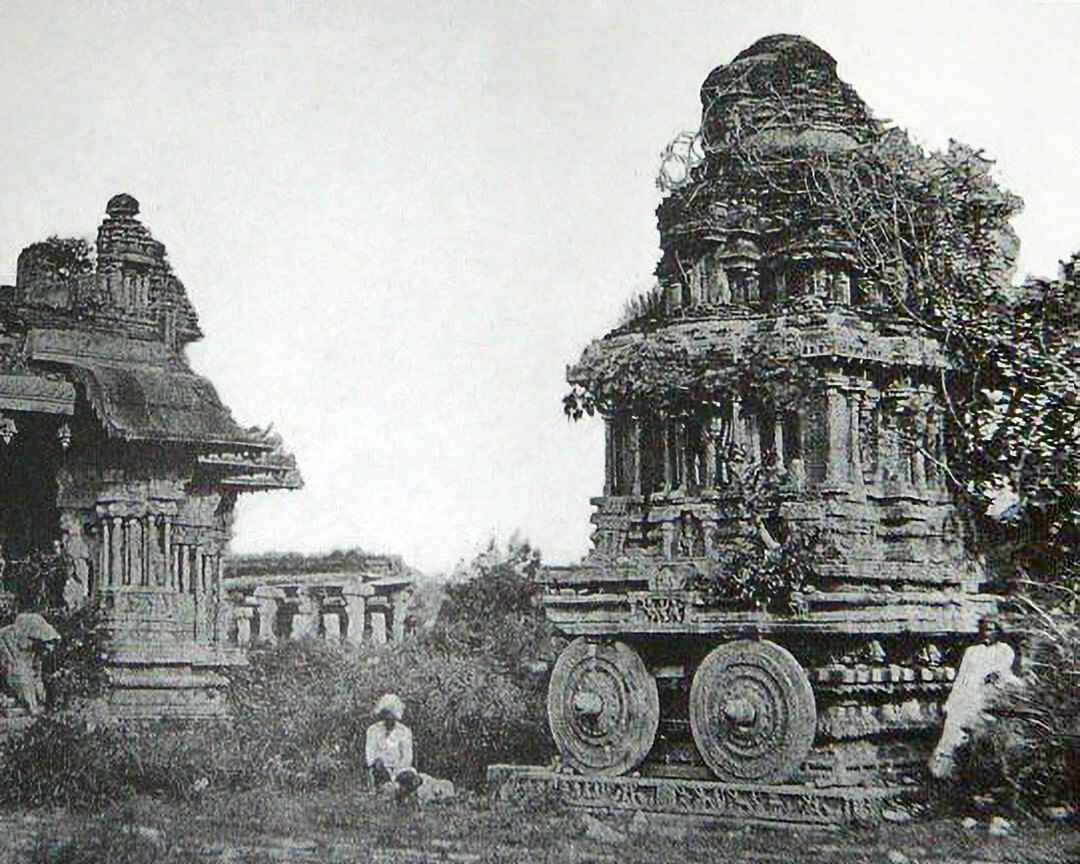
A Stone Chariot on 50 Rupee Note:
The Stone Chariot’s impact transcends its physical presence at Hampi. Recognized as a national treasure, the Indian government placed its image on the back side of the ₹50 note in August 2017.[4] This decision elevates the Stone Chariot beyond a historical monument and transforms it into a symbol of India’s cultural heritage.
Every time the ₹50 note changes hands, it carries a piece of Hampi’s legacy, silently promoting awareness and appreciation for this architectural marvel. The image on the currency ensures the Stone Chariot’s significance is not confined to history books but actively woven into the daily lives of millions of Indians.

The Maha Mandapa of Vittala Temple
The Maha Mandapa, also called the Sabha Mandapa, stands tall right across from the Stone Chariot. This massive hall leads to the inner sanctum (Garbha Griha) at one end. You climb a few steps flanked by elephant railings to reach this grand open hall.
The steps on the eastern side of the Maha Mandapa are embellished with elephant balustrades. The facade of the temple is lined with forty pillars, each standing 10 feet tall. Adorning these pillars are beautifully carved decorations, with the central area of the Maha Mandapa displaying 16 magnificent Narasimha and Yali sculptures. The lavishly designed ceiling of the Maha Mandapa adds to the grandeur of the temple, with ornately carved pillars representing its magnificence.
The most amazing thing about the Maha Mandapa is its roof. It’s supported by huge clusters of slender pillars, all carved from single giant blocks of granite! These special pillars are famous for creating musical notes when you tap them, earning them nicknames like “Vittala Temple Musical Pillars” or “SAREGAMA pillars”.
The Maha Mandapa itself is actually four smaller halls combined. The eastern hall has carvings of musicians, dancers, and drummers on its pillars, making it the “musician’s hall”. The southern hall features mythical creatures called Yalis, while the northern hall showcases sculptures of Narasimha, the man-lion form of Lord Vishnu. One particularly interesting sculpture depicts Narasimha slaying the demon king Hiranyakashipu, with the king’s pious son Prahlada kneeling in prayer. If you walk further north, you’ll find the entrance to the inner sanctum.
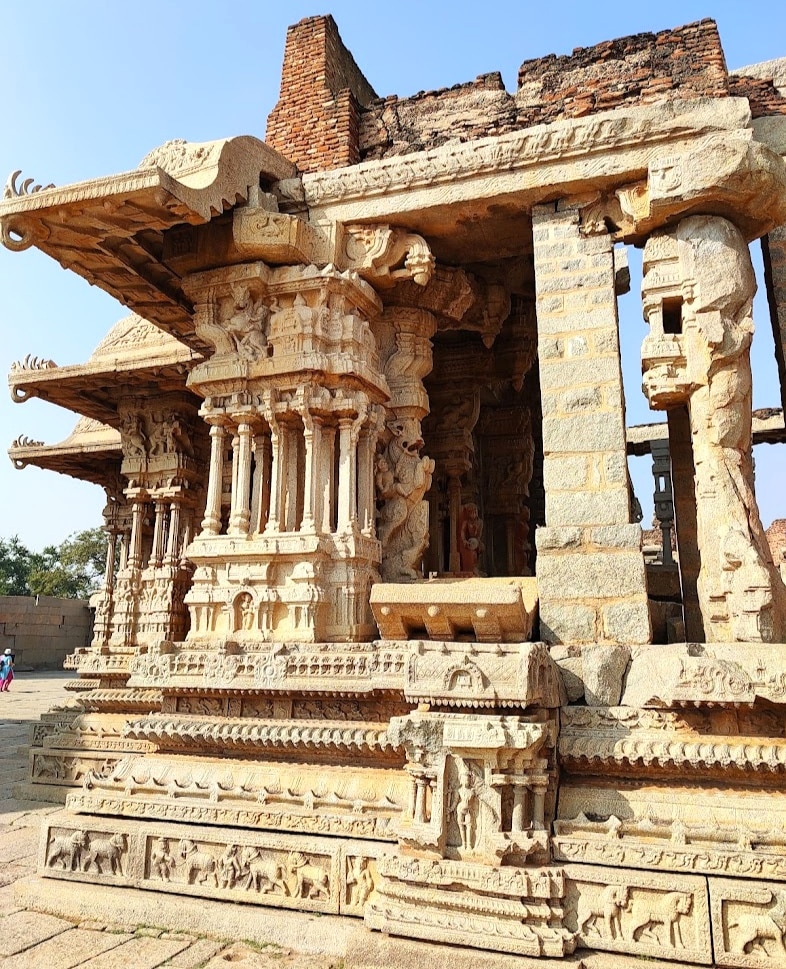
Ranga Mandapa
The Ranga Mandapa, which is the temple’s most impressive part, is reached via the mukha mandapa. The pillars represent Dravidian characters. The ornamental aspect of the mandapa’s composite pillars, as well as the intricate carvings of gods and goddesses and fretwork, makes them especially remarkable. A huge enclosure with sixteen exceptionally gorgeous towering pillars stands in the centre.
The Garbha Griha of Vittala Temple
The Garbha Griha, the holiest part of the Vittala Temple, is located behind the Sabha Mandapa, directly in line with the Stone Chariot. You can reach it through a doorway or by climbing a set of steps on the south side. Traditionally, guardian figures called Dwarapalakas would have stood at the entrance, but only one partially damaged statue remains today.
Sadly, the Garbha Griha is currently empty, and the idol of the deity is missing. However, carvings on the outer walls and the Gopuram (gateway tower) offer clues about what the idol might have looked like. These carvings depict various gods and goddesses, including Lord Vishnu himself.
The covered and dim pathway for circumambulation, known as the pradakshina path, envelops the sanctum of the temple. Positioned below ground level, this pathway exudes a somewhat subdued atmosphere, with dim lighting casting a peachy darkness. As devotees walk along this pathway in a clockwise direction, they engage in the sacred practice of circumambulation.
The outer walls of this sacred space are decorated with intricate carvings including “Kumbha-Pankaj” motifs and other symbols associated with Lord Vishnu. Even though the idol is gone, the Garbha Griha retains a sense of peace and reflects the rich history of the Vittala Temple.
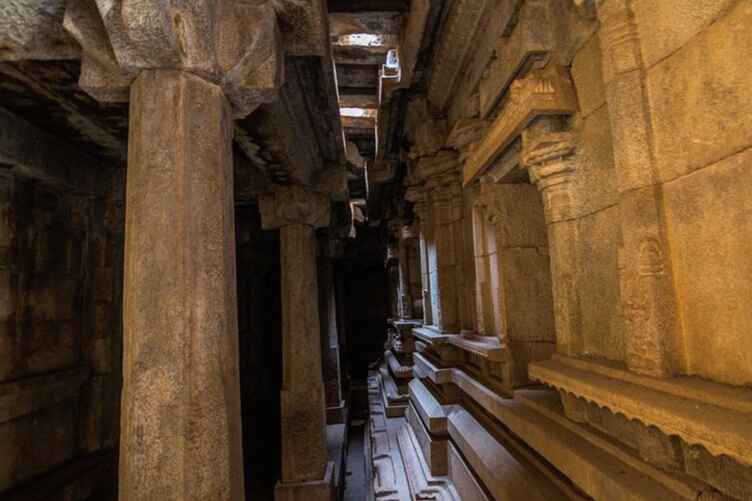
Pushkarani of Vittala Temple
The Pushkarani of Vittala Temple is a large tank, measuring about seven meters in length. It was built in the 16th century and has an ornate main entrance from the South. This tank was used during Teppotsava festivities associated with the Vitthala temple.[5]
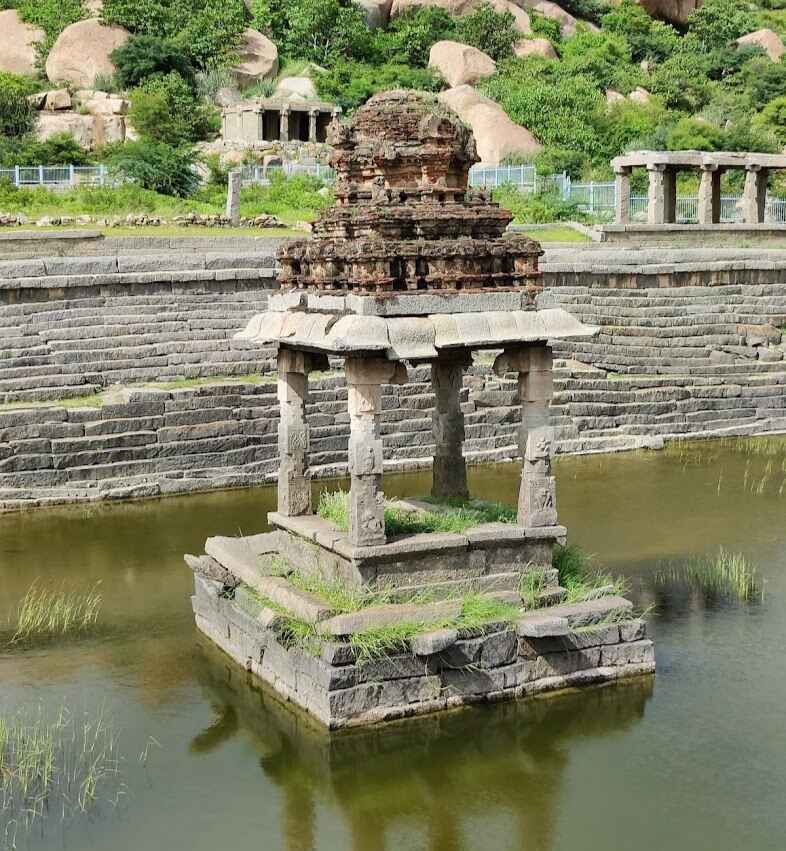
It was enclosed by a pillared cloister, evident from its remnants on all four sides. At its western end, there is a processional deity pavilion with a raised platform. On the northern side, the landing is built in three stages, with fixed anchor stones about halfway down for tying boats or coracles.
In the center of the tank is a four-pillared pavilion with a pointed roof made of brick and lime. The exterior of the pavilion is decorated with shala, kuta, and panjara motifs. This pavilion was used for displaying and worshiping the utsava murti during certain festivities.
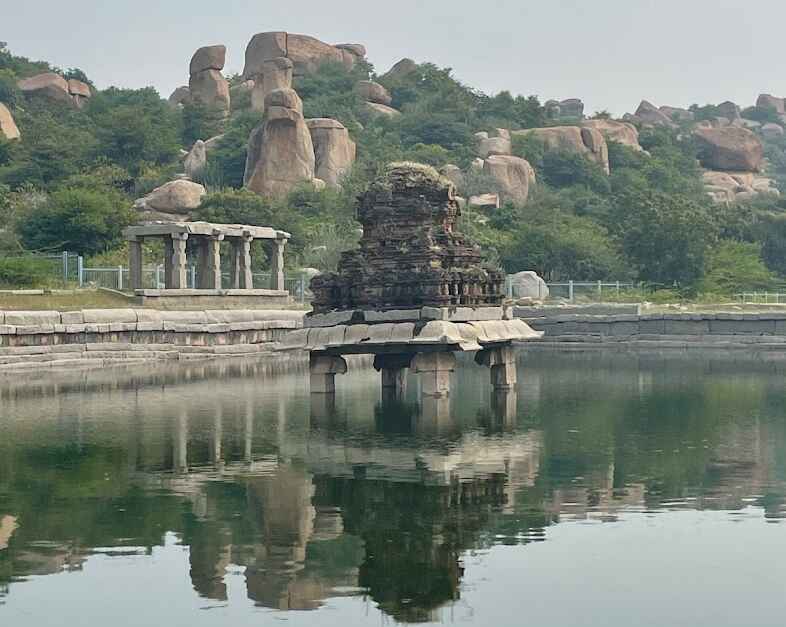
Vittala Bazaar
The Vittala temple complex is surrounded by car streets on all four sides. These streets, which are longer and wider than others in Hampi, were designed with large, iconic temples at their fronts, flanked by ceremonial colonnades. The colonnades, dating back to the 16th century, served as resting places and shops, while the grand buildings were used by royalty.[6]
The main Eastern car street is built on a bed of sand and silt and is topped by a split boulder pavement. Architects identified and planned water harvesting sites to ensure a continuous water supply to the large rectangular tank and smaller tanks in the area.
The row of mantapas (open pavilions) along the streets exhibits simple architecture. Closer to the Vittala temple complex, at the southeast corner, two-story mantapas can be seen. Numerous Vaishnava temples, shrines, and mathas (monastic establishments) existed along the car streets surrounding the Vittala Temple.

Current State of Vittala Temple
The Vittala Temple in Hampi is partially damaged. The sanctum, where an idol of Lord Vittala once stood, is now empty. The main western hall of the temple was destroyed long ago during an attack by the Deccan sultanates in 1565 A.D., which led to the downfall of the Vijaynagara Empire. The wheels of the chariot, which were once movable and could be turned by visitors, have been sealed by the Indian government to prevent damage.
Additionally, tapping the musical pillars to produce sounds is prohibited, as it has caused harm to the pillars in the past. Similarly, touching the musical pillars to make them emit musical notes is also not allowed, as it has led to damage over time.
Vittala Temple Entrance Fees
Planning a trip to the Vittala Temple? Keep in mind there’s a cost to enter the temple grounds. The fee depends on your nationality. For visitors from India and some neighboring countries, the entry fee is quite reasonable. Foreign tourists from other countries will pay a bit more. The good news is that children under 15 get free admission!
Entry Fees Based on Nationality:
The entry fee to visit Vittala Temple varies depending on your nationality. Indian citizens and visitors from SAARC and BIMSTEC countries enjoy a minimal fee of 40 rupees (35 rupees online). SAARC stands for South Asian Association for Regional Cooperation, and BIMSTEC is the Bay of Bengal Initiative for Multi-Sectoral Technical and Economic Cooperation.
Foreign Tourists Fee:
Foreign tourists from countries outside of SAARC and BIMSTEC are required to pay a fee of 600 rupees (online 550 rupees) to enter Vittala Temple.
Free Entry for Children:
Children under 15 years old are granted free entry to Vittala Temple, regardless of their nationality. This allows families to explore the temple complex together without worrying about additional costs for young ones.
Ensuring Compliance:
It’s essential to adhere to the entry fee regulations and provide appropriate identification when purchasing tickets. Visitors should carry valid identification documents such as passports or government-issued IDs to verify their nationality and age.
Online or Offline:
You can purchase the ticket from the ticket counter located in front of the temple, or you have the option to buy it online to avail of a discount of five rupees and skip the long queue. The ticket is valid for one day only, from sunrise to sunset, and grants access to all monuments at Hampi, including the Archaeological Museum.

Electric Vehicles at Vittala Temple
The Vittala Temple complex offers a parking area located around 1 km before the main temple complex. From there, visitors can either walk or take a battery car to reach the temple. It is enough to buy a ticket by paying 10 rupees once. This ticket allows you to travel from the parking area to the temple complex and back. This initiative is particularly beneficial for those who may have difficulty walking long distances or navigating uneven terrain.
The introduction of electric vehicles not only improves accessibility but also promotes sustainable tourism practices in the historic site of Hampi. It reflects a progressive approach towards environmental conservation and responsible tourism by reducing carbon emissions and noise pollution in the area.
This initiative also represents a step towards gender equality and economic empowerment by providing employment opportunities for local women. By taking on roles traditionally dominated by men, these women drivers are breaking barriers and challenging stereotypes, contributing to the socio-economic development of the community.
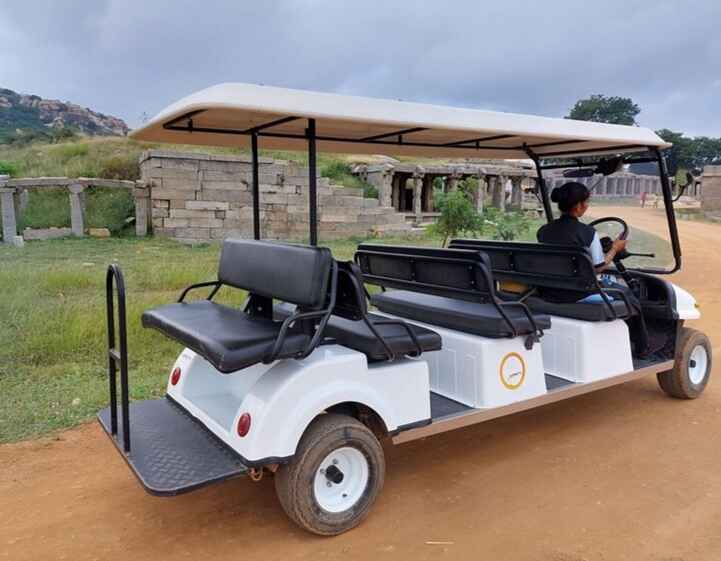
Must-See Attractions at Vittala Temple
When visiting the Vittala Temple in Hampi, there are several must-see attractions that should not be missed. These attractions highlight the architectural splendor, artistic brilliance, and spiritual significance of the temple complex. Here are some of the must-see attractions at Vittala Temple:
Stone Chariot:
The iconic Stone Chariot of Vittala Temple is a major highlight. This intricately carved stone structure resembles a chariot and is considered a masterpiece of Vijayanagara architecture. Its exquisite craftsmanship and symbolic significance make it a must-see attraction.
Musical Pillars:
The musical pillars are another unique feature of Vittala Temple. These pillars, when gently tapped, produce musical sounds, resembling various musical instruments. The melodic resonance that fills the air is truly enchanting and adds to the temple’s mystical allure.
Pradakshina Path:
The covered and dim pathway for circumambulation, known as the pradakshina path, envelops the sanctum of the temple. Positioned below ground level, this pathway exudes a somewhat subdued atmosphere, with dim lighting casting a peachy darkness.
Gopuras (Towers):
The towering gopuras or entrance towers of Vittala Temple are architectural marvels. The elaborate carvings, intricate designs, and ornate sculptures on these gopuras are a sight to behold. Each gopura tells a story and showcases the artistic prowess of the Vijayanagara artisans.
Ranga Mantapa:
The Ranga Mantapa is a large pillared hall within the temple complex. It is known for its intricately carved pillars and ceilings, adorned with mythological figures and motifs. This magnificent hall was used for religious and cultural events, and exploring its architectural grandeur is a must.
Pushkarani:
Take a moment to explore the ancient stepwell located within the temple complex, which served as a sacred water reservoir for ritual purposes.
Vittala Bazaar:
Explore the nearby Vittala Bazaar, an ancient market street that once bustled with activity and commerce, offering a glimpse into Hampi’s vibrant past.
Outer Enclosures:
Wander through the outer enclosures of the temple complex, which feature remnants of smaller shrines, pavilions, and intricately carved gateways.
Surrounding Landscape:
Take in the panoramic views of the surrounding landscape, dotted with boulders, ruins, and lush greenery, offering a picturesque backdrop to the temple complex.
Tips for Visitors to Vittala Temple
To ensure a fulfilling and enriching visit, here are some valuable tips for travelers. By following these suggestions, you can maximize your experience at Vittala Temple and create lasting memories amidst the ancient ruins of Hampi.
Plan Your Visit Wisely:
Start your day early to avoid the crowds and the heat. Vittala Temple is open from 8:30 a.m. to 6:00 p.m., so plan to arrive early in the morning or late in the afternoon for a more serene experience.
Carry Cash:
Since there are no ATMs within Hampi, and sometimes making payments through UPI can be troublesome due to weak signals in certain areas, it’s advisable to carry some cash for any purchases you might make near the parking area or at nearby eateries.
Bring Snacks and Water:
While there are restrooms and water fountains available, there are no food stalls near the temple complex. Carry some snacks and a reusable water bottle to stay hydrated and energized during your visit.
Wear comfortable footwear:
The temple complex involves walking on uneven surfaces and stone pavements. It is advisable to wear comfortable shoes or sandals that provide good grip and support.
Sun Protection:
Hampi’s climate can be harsh, especially during the day. Bring a hat, sunglasses, and sunscreen to protect yourself from the sun’s rays while exploring the temple complex.
Engage with Guides:
Hiring a local guide can greatly enhance your understanding of the temple’s history, architecture, and mythology. They can provide insightful information and help you navigate the complex. Negotiate the price beforehand and ensure that they are authorized guides.
Respect Temple Rules:
Follow the temple rules and regulations, including photography restrictions and areas where footwear needs to be removed. Respect the sanctity of the temple and its surroundings.
Explore Nearby Attractions:
Take the time to explore other nearby attractions in Hampi. Here is a list of Places to Visit in Hampi.
Be mindful of photography:
Photography is generally allowed within the temple complex, but be mindful of the surroundings and the privacy of other visitors.
Enjoy the Serenity:
Lastly, take moments to soak in the serenity and spirituality of Vittala Temple. Find a quiet spot to sit and reflect amidst the ancient surroundings, allowing yourself to connect with the rich history and culture of Hampi.
Gallery:-
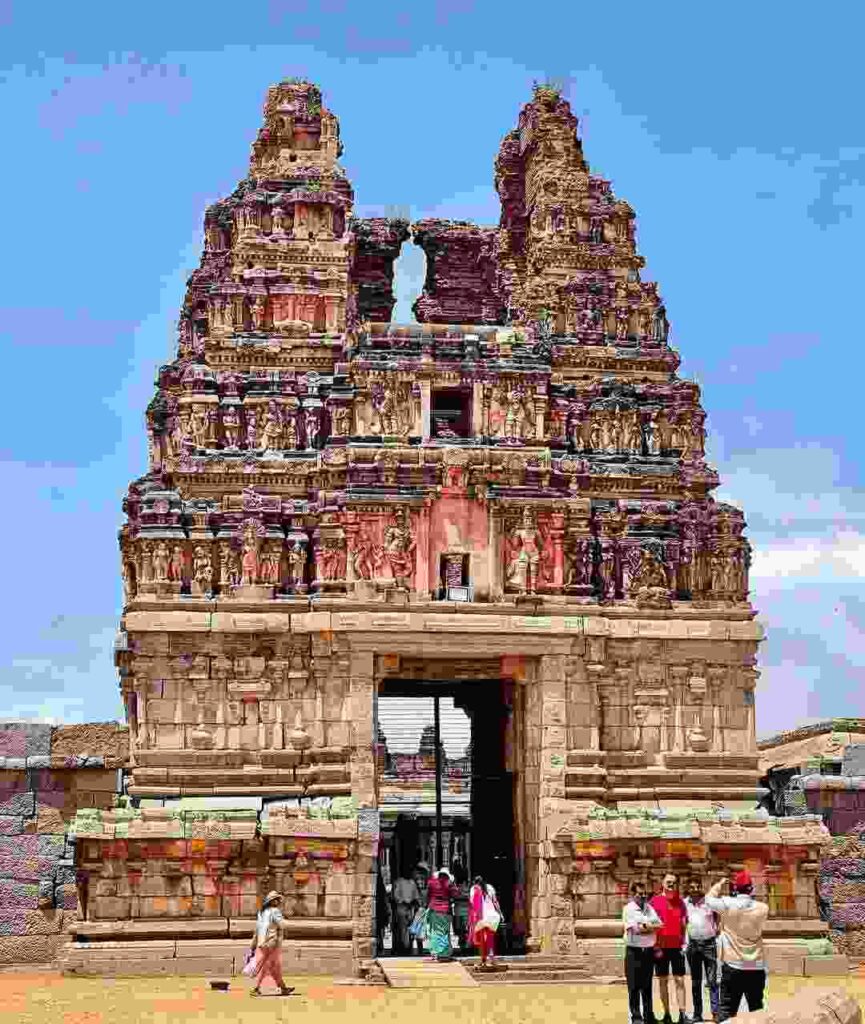
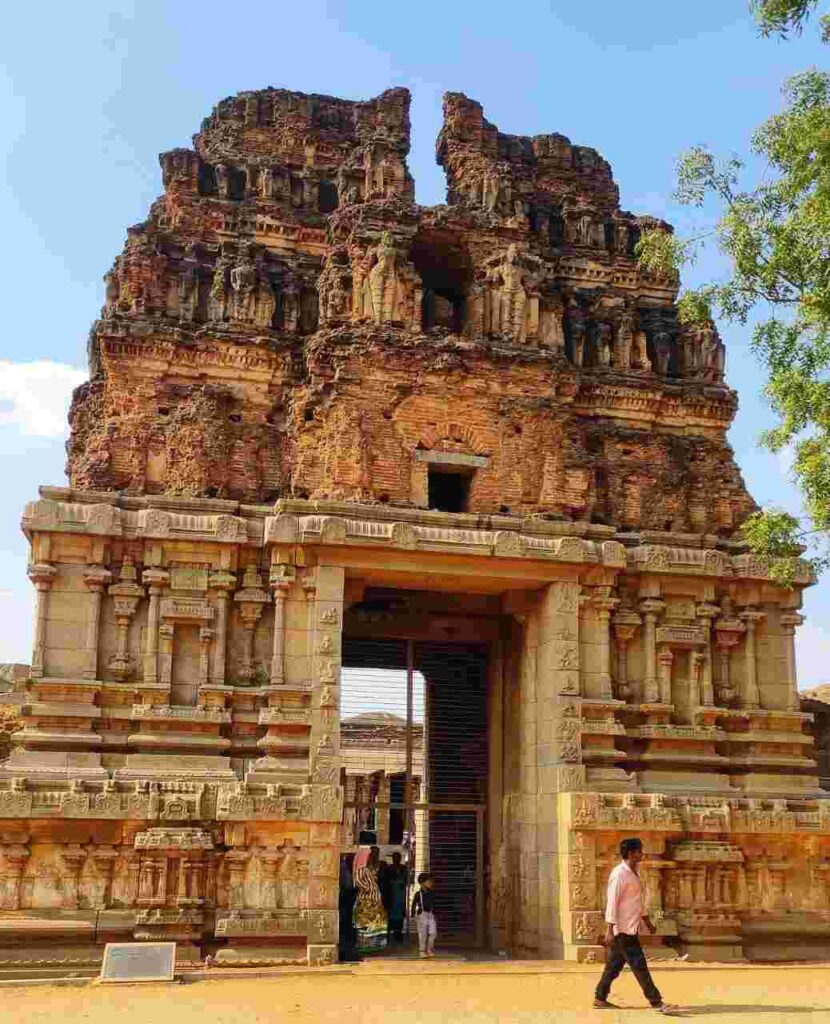

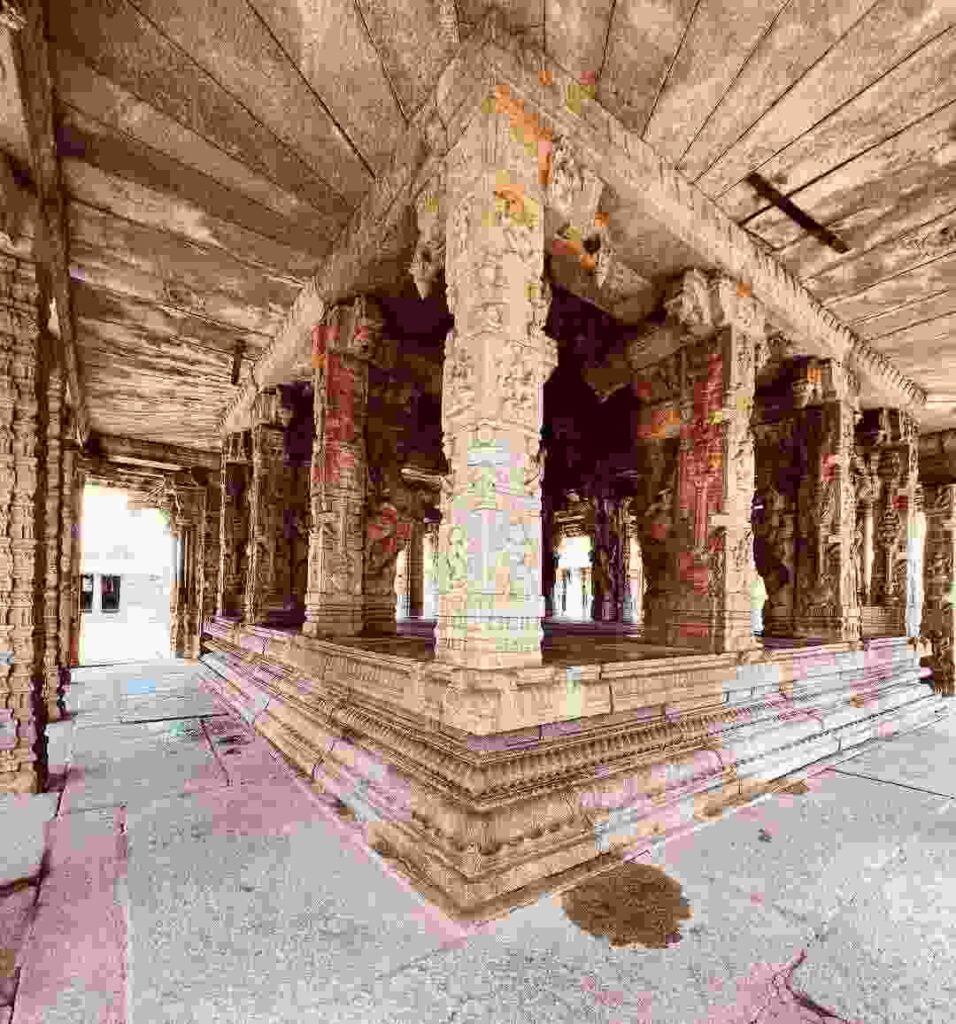

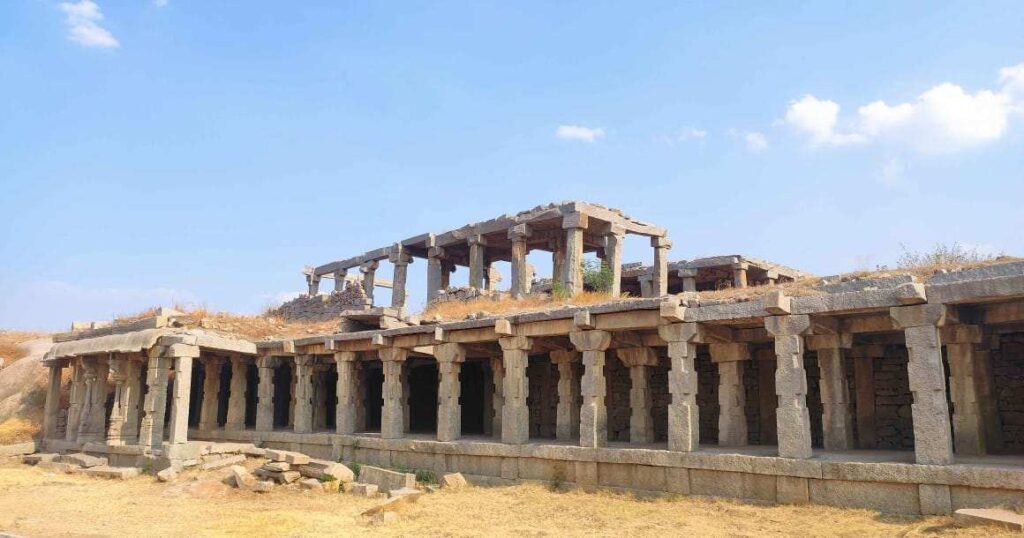
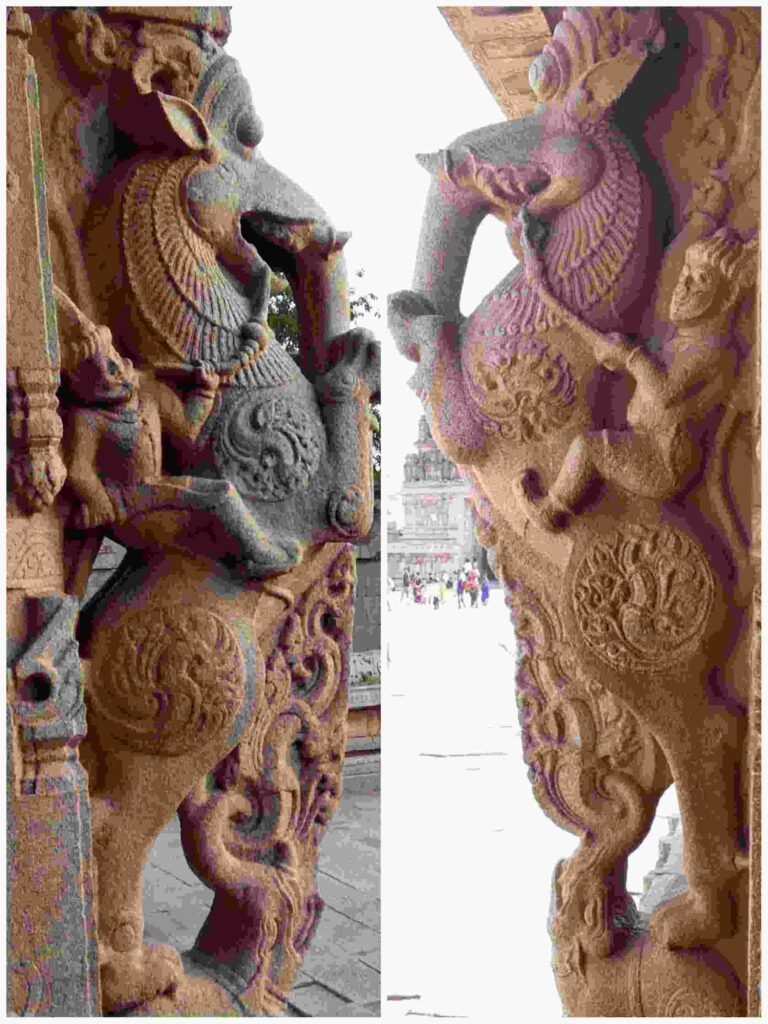
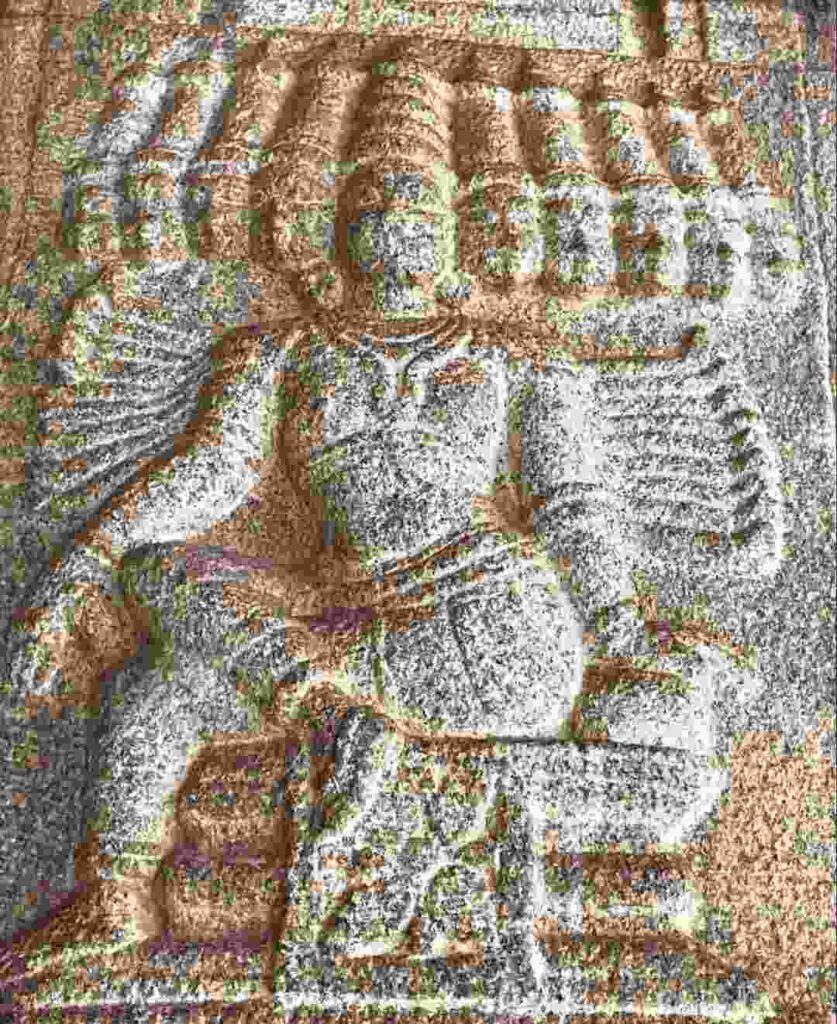
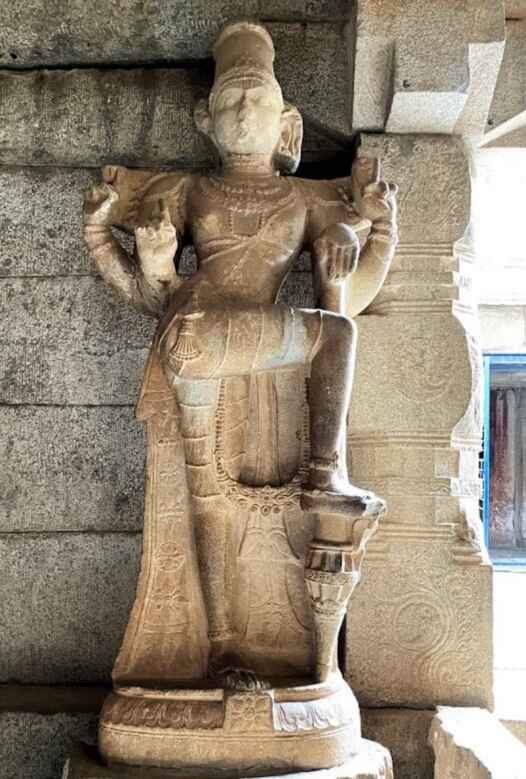

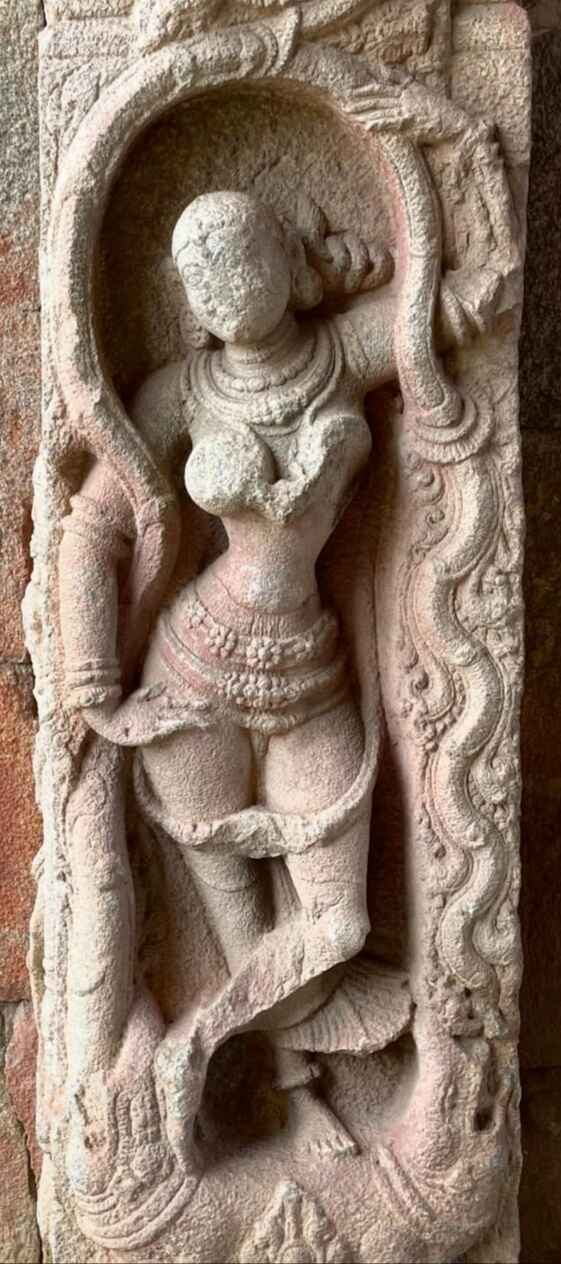
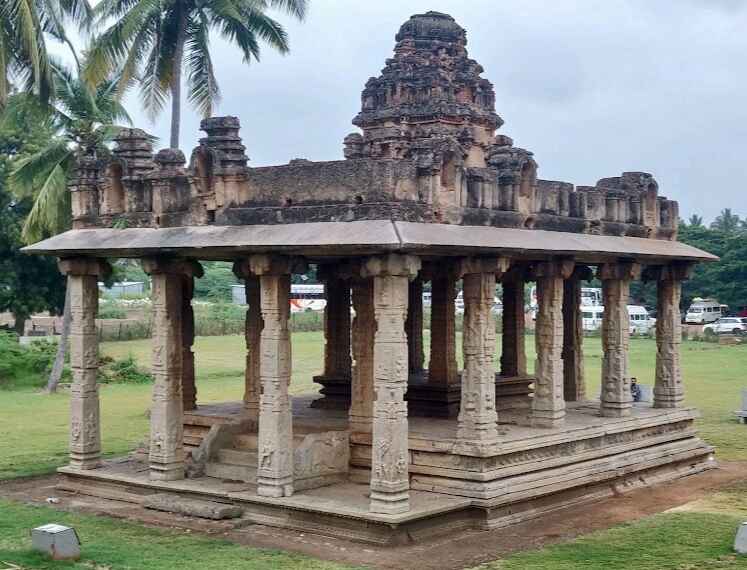
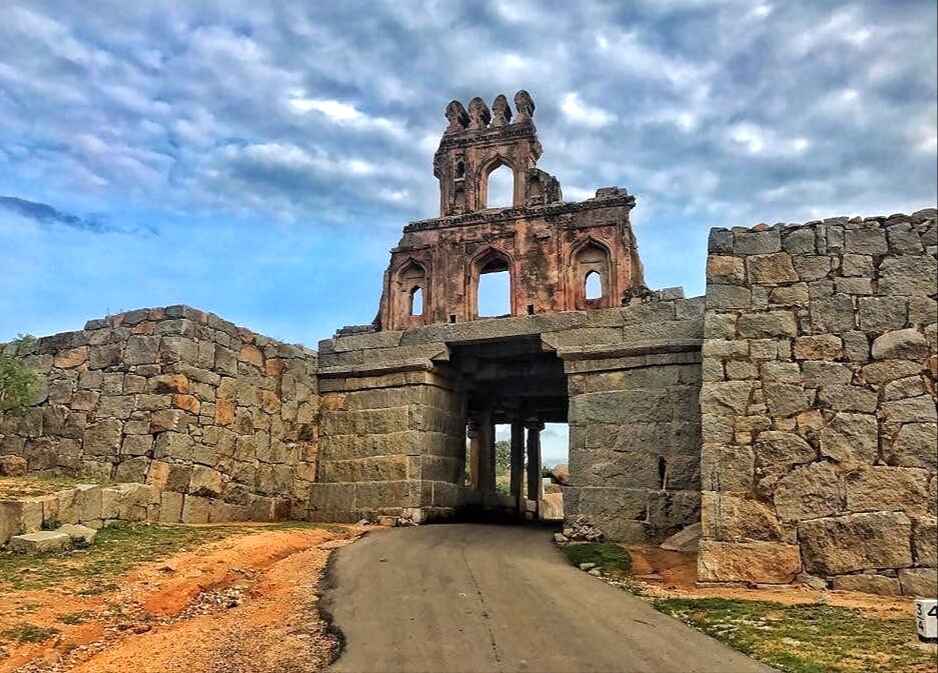
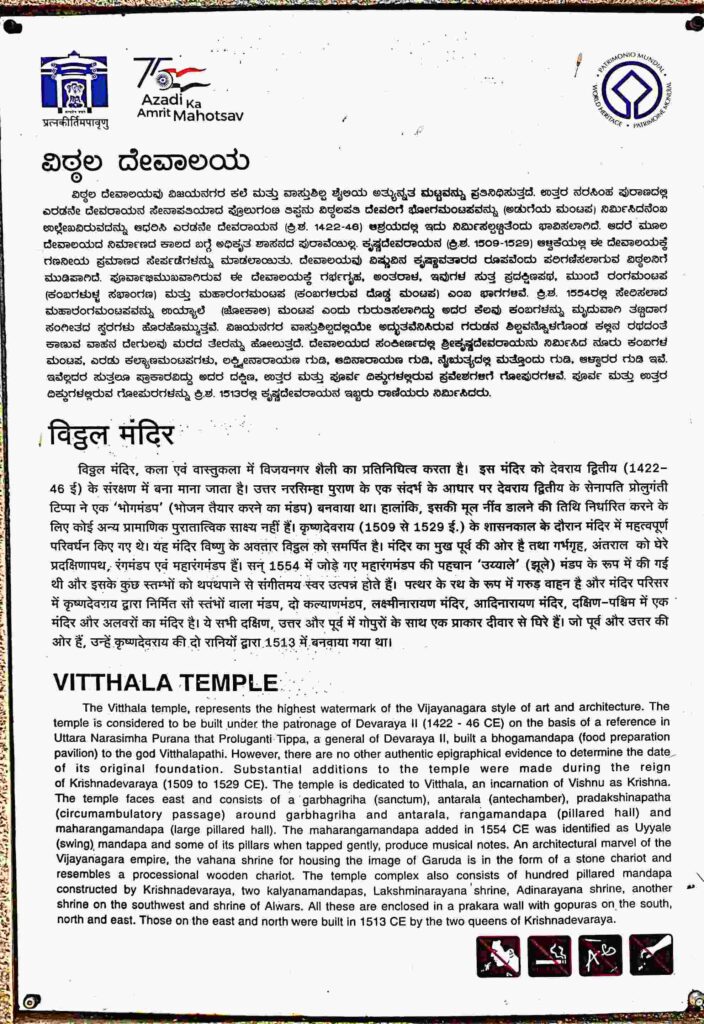

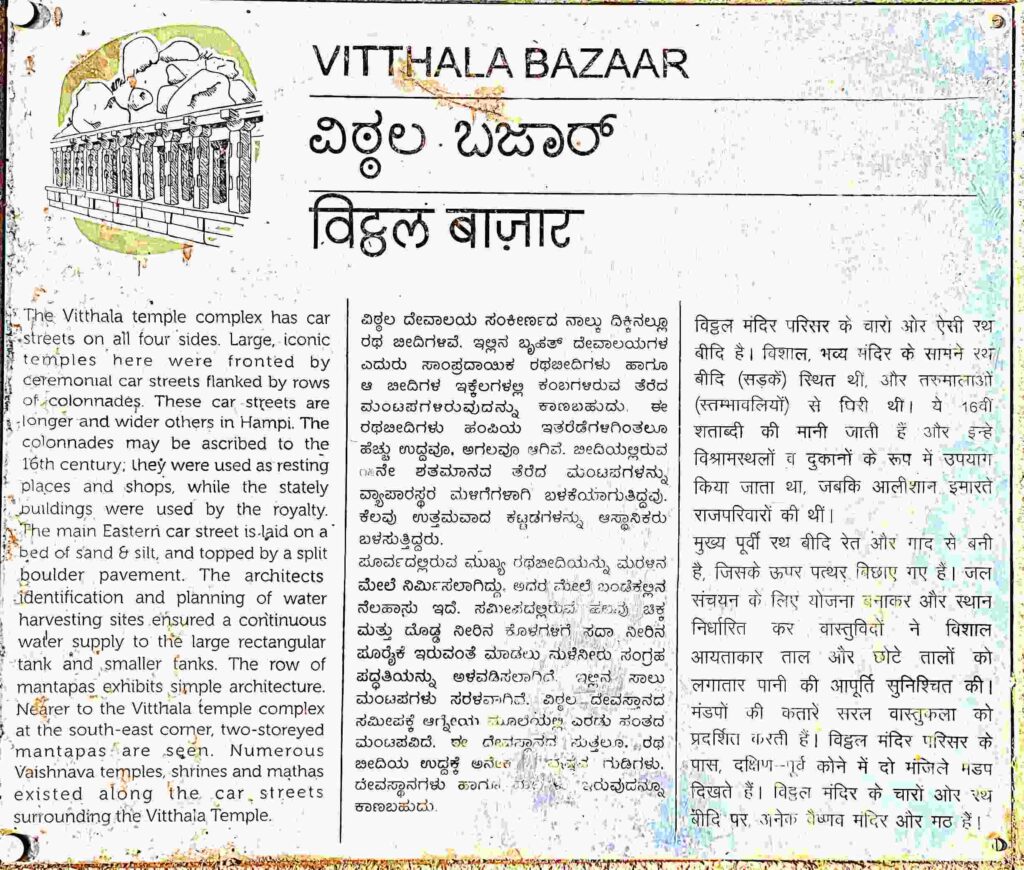
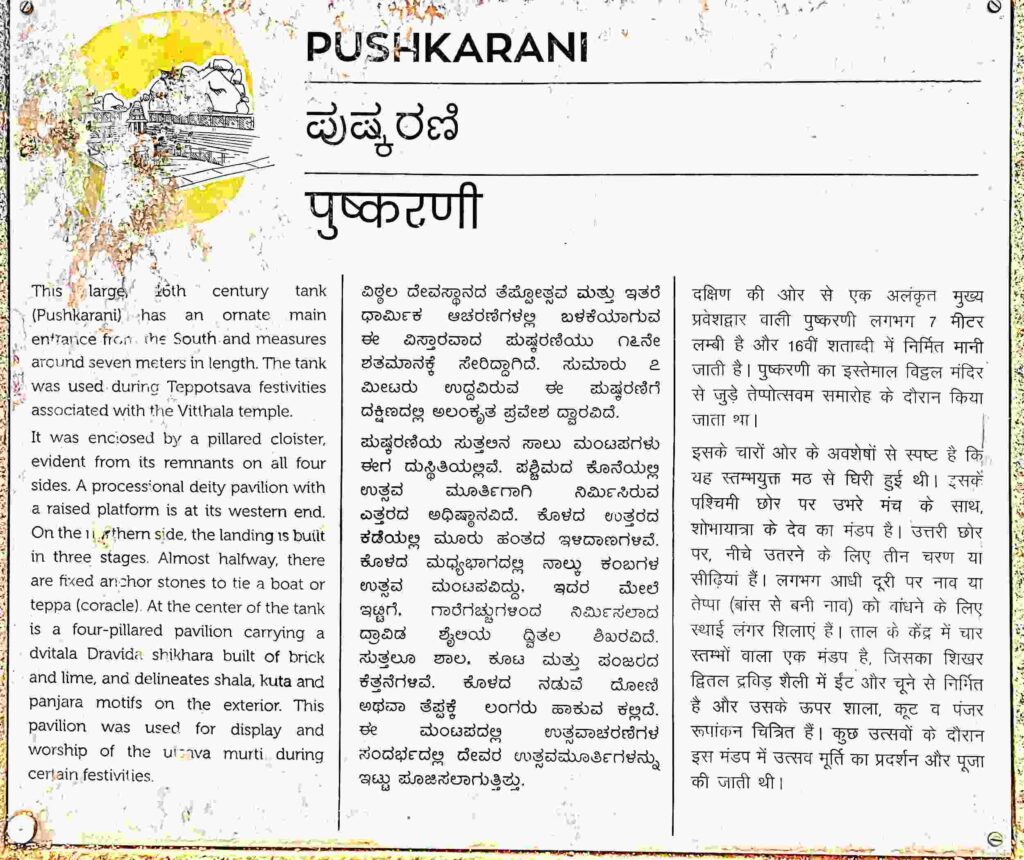
References:-
References from the Following Sources;
- ^[1] ^[2] – The history of Vittala Temple was sourced from the ASI Information plaque (new) located at the front of the temple.
- ^[2] – The history of Vittala Temple was sourced from the ASI Information plaque (old) located at the front of the temple.
- ^[3] – Vijay Vittala Temple, an Architectural Masterpiece with Mysterious Musical Pillars – IJRPR
- ^[4] – Did you notice these iconic indian monuments on our currency notes? – Times of India
- ^[5] – Information about Pushkarani was sourced from the ASI Information plaque located at the front of the Pushkarani.
- ^[6] – Information about Vittala Bazaar was sourced from the ASI Information plaque located at the Bazaar.
- A systematic study on Vijayanagra Art and Architecture an outline, Dr. Anand Kumar
- Musical Pillars and Singing Rocks, M.G. Prasad and B. Rajavel
- Musical Curiosities in the Temples of South India, H. V. Modak